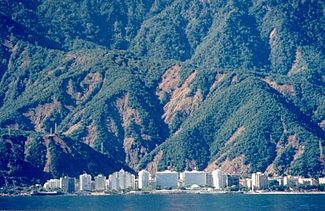Vargas tragedy

A part of Vargas state after the 1999 mudslides
|
|
| Date | 14 December 1999 – 16 December 1999 |
|---|---|
| Location | Vargas State, Venezuela |
| Deaths | 10,000–30,000 |
 Location of Vargas in Venezuela |
|
Coordinates: 10°36′18.67″N 66°50′58.21″W / 10.6051861°N 66.8495028°W
The 1999 Vargas tragedy was a disaster that struck the Vargas State of Venezuela on 15 December 1999, when the torrential rains and the flash floods and debris flows that followed on December 14–16 which killed tens of thousands of people, destroyed thousands of homes, and led to the complete collapse of the state's infrastructure. According to relief workers, the neighborhood of Los Corales was buried under 3 metres (9.8 ft) of mud and a high percentage of homes were simply swept away to the ocean. Whole towns like Cerro Grande and Carmen de Uria completely disappeared. As much as 10% of the population of Vargas perished during this event.
The coastal area of Vargas has long been subject to mudslides and flooding: geologically similar catastrophes occurred with regularity. The most recent major flood was in 1951, however that event did not cause as much damage. The unusually strong storm in December 1999 dumped 911 millimetres (35.9 in) of rain over just a few days, triggering soil instability and flow of debris. The state had experienced high population growth and development since the previous major disaster in 1951, thus increasing the toll of casualties.
Since the 17th century, at least two large-magnitude debris flow, landslide, or flood events, on average, have occurred each century within the modern boundaries of Vargas State. Recorded events occurred in February 1798; August 1912, January 1914; November 1938, May 1944, November 1944, August 1948, and February 1951. The deposits preserved on the alluvial fan deltas here show that these events occurred back through prehistoric times.
In the February 1798 event, flash floods and debris flows severely damaged 219 homes. Spanish soldiers barricaded an upstream-facing entrance to a fort with cannons in order to prevent debris from filling it.
...
Wikipedia
